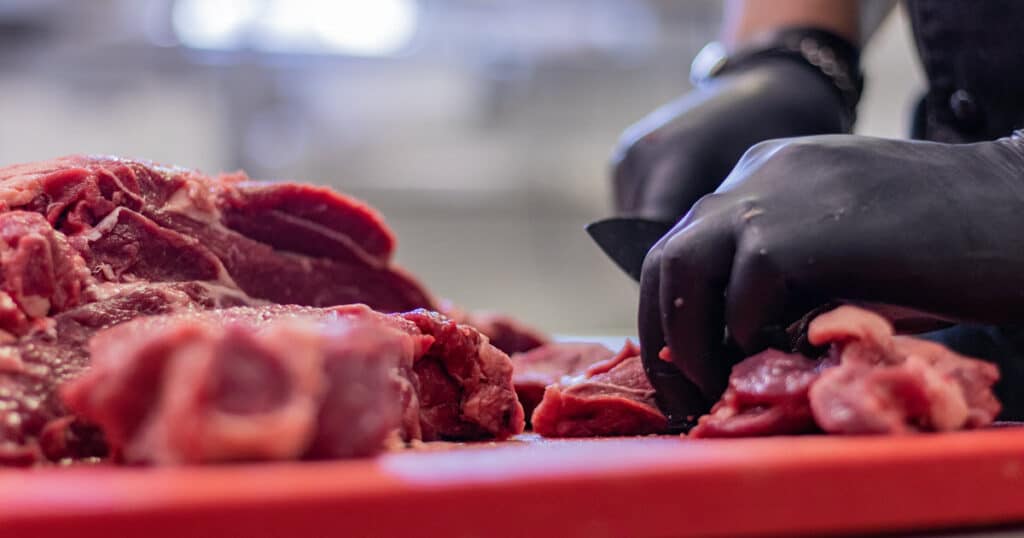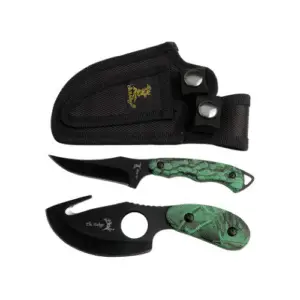The challenge and thrill of deer hunting appeal to many hunters because it offers the chance to observe wildlife, establish a connection with nature, and participate in an activity that requires different skills. For others, deer hunting is an activity that’s handed down from one generation to the next and aims to fortify bonds amongst family members and those within the community. But besides being a hobby, a family tradition, or a way to develop one’s tracking and marksmanship skills, deer hunting is also considered an important food source. So, how much meat from a deer can you get after a successful hunt?
A deer can yield between 45 and 75 pounds of meat on average. The exact amount of meat depends on several factors, including the deer’s age, size, and gender. Meat yield also depends on the dressing method, the specific cut, and the hunter’s skill and experience in harvesting deer meat.
Factors That Affect the Amount of Meat
Table of Contents
ToggleMany variables affect how much meat a deer yields, and these might differ from one animal to the next. The following are some important factors that influence a deer’s meat yield:
The Age of the Deer
A deer’s age affects the maturity of its muscle tissue, which impacts the tenderness or toughness of deer meat. Due to their more developed muscle tissues, older deer may have tougher cuts.
In contrast, because their connective tissues are less dense, younger deer—like fawns—generally offer more tender meat.
Also, older deer might have more bone mass, which could lower their overall yield of meat.
The Deer’s Size
There are two ways that a deer’s size affects meat yield significantly.
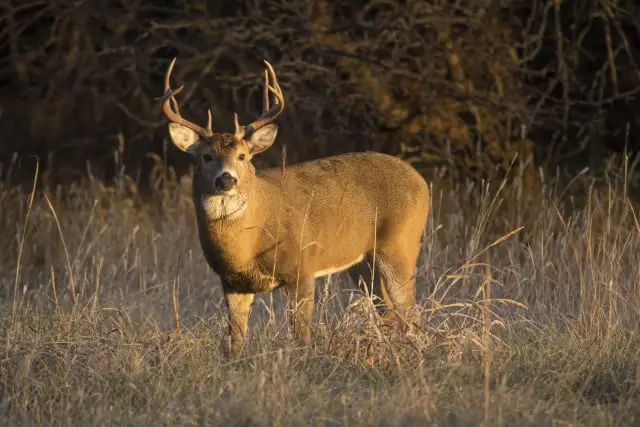
First off, because larger deer have larger bodies, they often have larger muscles, which means that they have more meat overall—including bigger cuts like steaks and roasts.
Second, the amount and size of different cuts can be influenced by the size of the deer; larger deer often yield more substantial hindquarters, which results in larger slices of meat altogether.
The Gender of the Animal
The gender of a deer plays a key role in how much meat a deer can produce, mainly because of the differences in size.
Male deer, or bucks, can potentially yield more meat than female deer, or does, because bucks have longer antlers and larger bodies.
Another factor that influences hunters’ decision-making when harvesting deer is their perception that meat from does—especially younger ones—tastes softer than that of bucks.
Field Dressing Technique
Field dressing has a significant impact on the quantity and quality of meat harvested from deer. To keep meat fresh, stop bacteria from growing, and keep it from spoiling, proper cooling methods are crucial.
By quickly removing internal organs, this procedure minimizes contamination and lowers the possibility of bacterial transmission.
It also decreases the total weight of the carcass, which makes handling and transportation easier even though it has no effect on the overall meat yield.
Careful handling is necessary to avoid tainting the meat from punctures in the intestines or bladder during field dressing.
Shot Placement
When it comes to deer hunting, shot placement is quite important because it affects the yield and quality of meat.
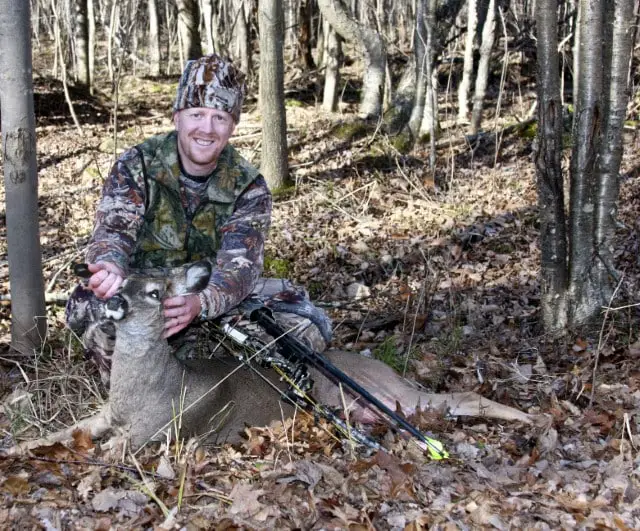
Preserving meat quality requires not just an ethical harvest but also accurately targeting important organs such as the heart or lungs to achieve a swift and humane kill.
This method reduces the deer’s stress and suffering, which results in a more humane harvest.
Meat Processing Practices
Processing techniques are essential for maximizing the amount and quality of meat after a deer is harvested. To ensure the yield of high-quality cuts, such as steaks, roasts, and ground meat, and to maximize the amount of usable meat, skilled butchering and processing are necessary.
Adhering to proper processes yields meat that is varied and well-utilized, while also improving flavor and tenderness. Meat quality is also preserved until it is ready for consumption by appropriate handling and storage, such as freezing or refrigeration, which helps to keep it fresh and stop spoiling.
Deer Field Dressing and Processing
The quality of meat harvested from deer requires careful handling during the field dressing and processing phases.
Quick field dressing keeps the meat fresh and lowers the chance of bacterial growth by rapidly chilling it. By reducing the amount of microorganisms that contaminate food, this method yields a safer and cleaner end product.
Field Dressing
To maintain the freshness and quality of the meat, field dressing must be done as soon as the deer is harvested.
It entails cutting up the deer’s belly to expose the chest cavity and gently extracting its internal organs. To prevent contamination, additional measures include cutting the diaphragm and windpipe and sealing the abdominal cavity, all while ensuring a hygienic process by cleaning the surrounding area. Hunters are advised to follow local laws and wear gloves for safety and hygiene.
Our Favorite Field Dressing Knife Set
We like fixed-blade hunting knives for field dressing and skinning deer (it’s a safety thing).
This 2-piece knife set is razor sharp, comfortable in the hand, and includes an effective gut hook. It’s a budget-friendly option that will be perfect for most hunters.
WorldDeer.org is reader supported. If you make a purchase after clicking a link, we may earn a commission at no additional cost to you.
Skinning and Quartering
Skinning and quartering a deer for human consumption involves suspending the animal from its hind legs and making precise cuts around the legs to methodically peel away the hide.
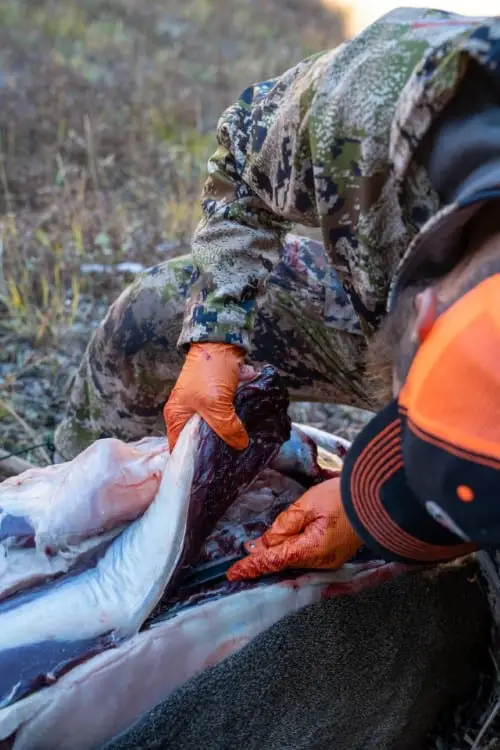
Subsequently, the front and rear sections are extracted with an emphasis on the joints, and the process is further segmented by making cuts along the spine and dividing the chest cavity.
Following their extraction, the backstraps are cut parallel to the spine. The meat is carefully wrapped, the excess fat is trimmed off, and it is kept in a freezer or refrigerator to maintain freshness.
Aging the meat
Aging improves the flavor and tenderness of deer meat by preventing the growth of bacteria after field dressing. It involves cooling the meat in a controlled environment, either by refrigerating or hanging it in a cool place.
Wet aging, practical for home use, keeps the meat moist, while dry aging allows the meat’s natural juices to evaporate and tenderizes it.
The typical aging period ranges from seven to fourteen days, with some opting for longer times based on specific cuts or preferences. The aging period is seven to 14 days, or longer, depending on preferences or specific cuts.
Butchering and cutting techniques
Different butchering methods enable hunters to get the most out of the deer meat. Here are some butchering and cutting techniques that may be used to increase productivity and provide high-quality cuts for cooking:
Quartering
Quartering involves splitting a deer carcass into manageable portions, usually the front parts (shoulders) and hindquarters.
Hunters separate these sections by carefully cutting through the joints with a sharp knife or saw, making it easier to process the meat into individual cuts like roasts and steaks.
Backstrap removal
Using a sharp knife, hunters carefully remove the lengthy muscles along the spine, known as the backstraps.
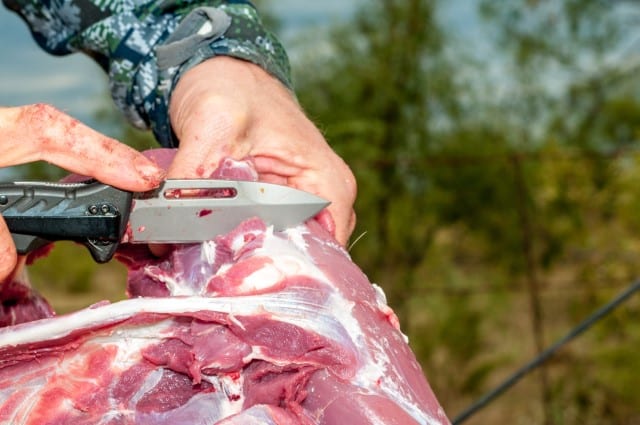
Because of their superior flavor and texture, these highly valued cuts are frequently utilized for steaks.
Steak cutting
Cutting a deer into individual steak parts requires removing the hindquarters and backstraps.
Hunters make sure these cuts are even and exact for the most tenderness by meticulously slicing them to the appropriate thickness with a sharp knife.
The resulting steaks, including fillet, T-bone, or sirloin, are a tasty way to prepare venison.
Roast preparation
Deer roast preparation utilizes larger muscle groups, typically from the shoulders or hindquarters, for slow cooking to enhance tenderness and flavor.
After trimming excess fat, hunters may tie the roasts to ensure even cooking and create uniform shapes.
Yield Estimates for Different Cuts of Deer Meat
The amount and quality of meat yield may vary depending on factors such as the size and weight of deer, the field dressing and meat processing techniques used, and the butchering skills of the hunter.

The following are just yield percentages of common deer meat cuts:
- Hindquarters (Bone-In): The hindquarters, which include the sirloin, round, and shank, can account for about 30-40% of the deer’s total weight.
- Trim and Ground Meat: Less tender sections and trimmings from different cuts can make up 20–30% of the total weight. This is frequently applied to processed goods like sausages and ground meat.
- Shoulders (Bone-In): As with the hindquarters, the shoulders account for 30–40% of body weight. Meats like roasts and stews frequently employ these cuts.
- Backstraps (Boneless): The backstraps, also called loin or tenderloin, are highly prized and typically yield 8-10% of the total weight. They are frequently cut into steaks.
- Neck Meat: Producing 5–10% of the overall weight, the neck is a versatile and tasty section of the animal. It works well for ground meat, stews, and roasts.
- Belly meat and ribs: This portion contributes less, often between 5 and 8%, and is frequently utilized for ground meat or trimmings.
These estimates serves as a general guide. Hunters frequently alter their cuts according to their own tastes and methods of cooking.
Deer Meat Storage and Preservation
Proper storage practices are essential in preserving the quality of deer meat and extending its shelf life.
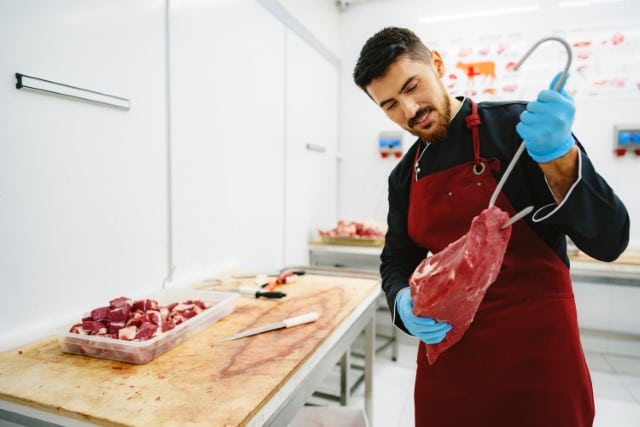
These methods minimize food waste, stop bacterial development, and spoilage—all of which are consistent with ethical hunting techniques.
Some examples of deer meat storage and preservation practices are:
Canning and Vacuum Sealing
By heating the meat in a sealed jar, canning removes microorganisms and prevents spoiling. Meanwhile, vacuum sealing removes air from the container to reduce freezer burn and prolong the freshness of the meat.
Jerky and Sausage Making
Jerky is made by thinly slicing deer meat, marinating it in a tasty blend of spices, and then smoking or dehydrating it.
Sausage is created by grinding deer meat, mixing it with seasonings and herbs, and occasionally adding extra ingredients like fat.
Freezing
Once the meat has been properly butchered, it is stored in vacuum-sealed bags or airtight containers to guard against air exposure and freezer burn.
The ideal temperature is 0°F (-18°C), to maintain ideal freezing conditions and preserve the quality and flavor of the deer meat until it’s time to consume it.
Tips to prevent freezer burn and spoilage
By following these suggestions, you can extend the shelf life of deer meat in the freezer while maintaining its flavor and freshness.
- Divide meat into smaller portions before storing in the freezer.
- Label each package with the cut type and processing date.
- Use airtight materials to reduce exposure to air.
- Do not overcrowd storage to allow air to circulate.
- Thaw meat in refrigerator or by submerging in cold water.
- Invest in high-quality equipment.
Deer Meat Recipes and Cooking Tips
Deer meat can be cooked in a variety of flavorful dishes.
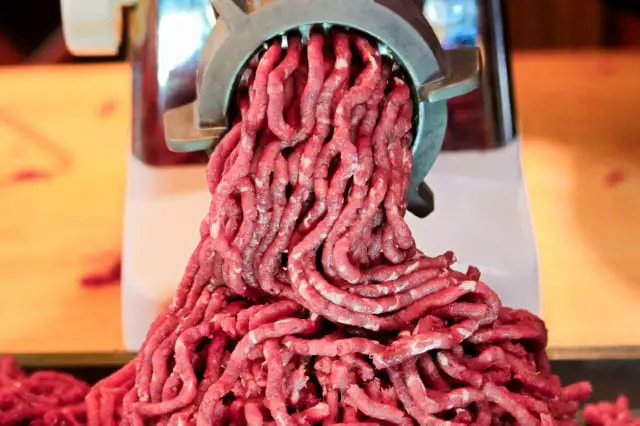
Here are some delicious venison recipes.
Deer Meat Skewers:
Ingredients:
- 1 pound deer meat, cut into cubes
- Salt and pepper
- Garlic powder
- Olive oil
- Wooden skewers, soaked in water
Instructions:
- Heat the grill or broiler.
- Put the cubes of deer meat onto the moistened skewers.
- Season the skewers with garlic powder, salt, and pepper after drizzling them with olive oil.
- Roast the meat on the skewers for 3–4 minutes on each side.
- Along with your preferred side dishes or dipping, serve the deer meat skewers hot.
Venison Stir Fried Rice
Ingredients:
- 1 pound venison, thinly sliced
- Vegetable oil
- Soy sauce
- Cooked rice
- Frozen mixed vegetables (corn, peas, carrots)
- Chopped green onions (optional)
Instructions:
- In a large wok or skillet, heat the vegetable oil over medium-high heat.
- Cook and brown the venison slices by stirring them in a pan, then remove them.
- Heat the frozen mixed veggies by stirring them in the same skillet, adding a little more oil if necessary.
- Add the cooked rice and drizzle with soy sauce. Break up clumps of rice as you stir.
- Add back the cooked venison then toss until ingredients are thoroughly mixed.
- Garnish with chopped green onions and serve hot.
Venison Cooking Tips
Deer meat or venison can be flavorful and tender when cooked right. Keep in mind these tips to achieve the best results:
- Marinate by adding herbs, spices, and acidic ingredients to improve flavor and tenderness.
- Cook in medium or medium-rare doneness and avoid overcooking.
- Add fat, such as butter, bacon, or olive oil while cooking to retain moisture.
- Use meat tenderizer or braise tougher cuts.
- Let cooked venison sit for a little while before serving.
Frequently Asked Questions (FAQs)
Still have questions about the meat yield from a deer? Here are answers to a few common questions we receive on this topic:
How many meals can you make from a deer?
The amount of meals you can make out of a deer varies depending on its size and the cuts you harvest.

But generally speaking, a deer can yield a wide variety of dishes, such as roasts, stews, soups, jerky, sausages, and more, giving you plenty of culinary options to best utilize it.
What are some alternative uses for deer parts?
Beyond their culinary use, deer parts provide a variety of other purposes.
Antlers can be made into ornamental things, deer hides can be tanned and used for clothes or home décor, and bones can be used to make tools or organic fertilizer.
How does the taste of deer meat compare to other meats?
In general, venison has a richer, earthier flavor and is thinner than beef.
The flesh can be less fatty than certain typical meats, and it’s frequently described as having a more gamey flavor with a hint of sweetness.
Final Thoughts
Deer hunting offers a substantial food supply, and a typical deer will yield 45 to 75 pounds of meat on average, depending on age, size, and gender.
For the purpose of optimizing yield and maintaining quality, proper field dressing, shot placement, and meat processing techniques are essential.
Ethical hunting ethics and the preservation of freshness are two benefits of using efficient storage methods like canning and freezing.
These factors combine to make hunting enjoyable and sustainable.

